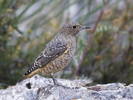search
classification
|
basic information
|
video
|
reports |
Rufous-tailed Rock Thrush
Monticola saxatilis (Linnaeus, 1766)

|
 male
|
|
|
2016-06-20
Baibiche gorge, Byorlyu pass |
© Oleg Belyalov
|
|
Description
The Rufous-tailed Rock Thrush is less than Starling. The spring male has the grayish-blue head, neck, back's fore and throat. The middle of the back is white; the rump is bluish-black. The uppertail, underparts and underwing coverts are rufous. The flight feathers and the upperwing coverts are blackish-brown. The central pair of the tail feathers is dark-brown, other ones are rufous. The bill and claws are black, legs are blackish-brown. The female in breeding plumage has buffy-brown upperparts; the head, back and rump have not always appreciable black scaly pattern. The uppertail is rufous. The chin and throat are dirty white, other underparts are buffy-sandy with dark-brown cross scaly pattern. The flight feathers are dark-brown with narrow light tips. The central pair of the tail feathers is rufous-brown, other ones are rufous. The Autumn male has dark brown buffy tinged upperparts. The underparts are orange-rufous; each feather has white tip and black terminal strip formed scaly pattern. The flight and tail feathers have broad whitish tips. The autumn female is similar to autumn male but has the browner yellowish mottled upperparts and the light-yellowish underparts. The juveniles are similar to female but the body feathers have white terminal strips. The flight feathers also have broad whitish or buffy-whitish tips. Weght 40-65 grams, length 23, wingspan 37, wing 11-13, tail 7 cm.
Biology
The Rufous-tailed Rock Thrush is common, in places rare breeding migrant. It is typical mountain bird. It inhabits the mountains when the rock, the clay precipices or the open places alternate with the bushes or tree groups on 500-600 till 2500-3500 m (in West Tien Shan); but in the sub-alpine and the alpine belts its number is very low. On migration it visits the steppes and desert plains with the broken lay of the ground. It appears in early-mid April singly or in small groups, in highlands in early-mid May only. Last migrants recorded in Kolshengel (Southern Trans-Balkhash area) on mid-May. It breeds in separate pairs not close one to another. The female builds nest in the cavity or in the rock cracks, between the stones, or on ground under stone; nest is built from the moss, the dry grass and rootlets and is lined with same but thinner materials. Clutch of 4-6 (usually 5) blue eggs founds on mid-May - mid-June. Both parents feed juveniles fledged in mid-June - late July. It eats the different insects and in autumn also the berries and fruits. The autumn migration is in August, latest birds recorded in mid-September.
References
"Птицы Казахстана" том 3. "Наука". Алма-Ата, 1970. Э.И.Гаврилов. "Фауна и распространение птиц Казахстана". Алматы, 1999. Gavrilov E. I., Gavrilov A. E. "The Birds of Kazakhstan". Almaty, 2005. А.Ф.Ковшарь "Певчие птицы". Алма-Ата, "Кайнар", 1983.












